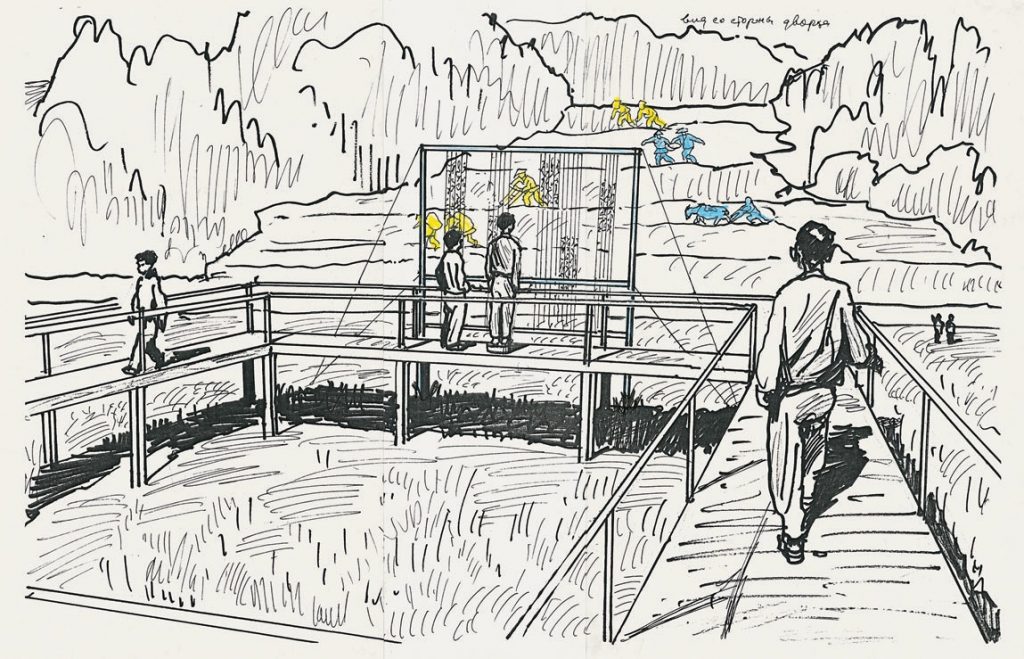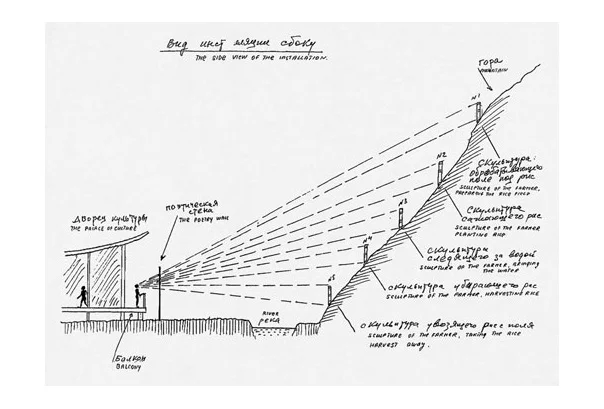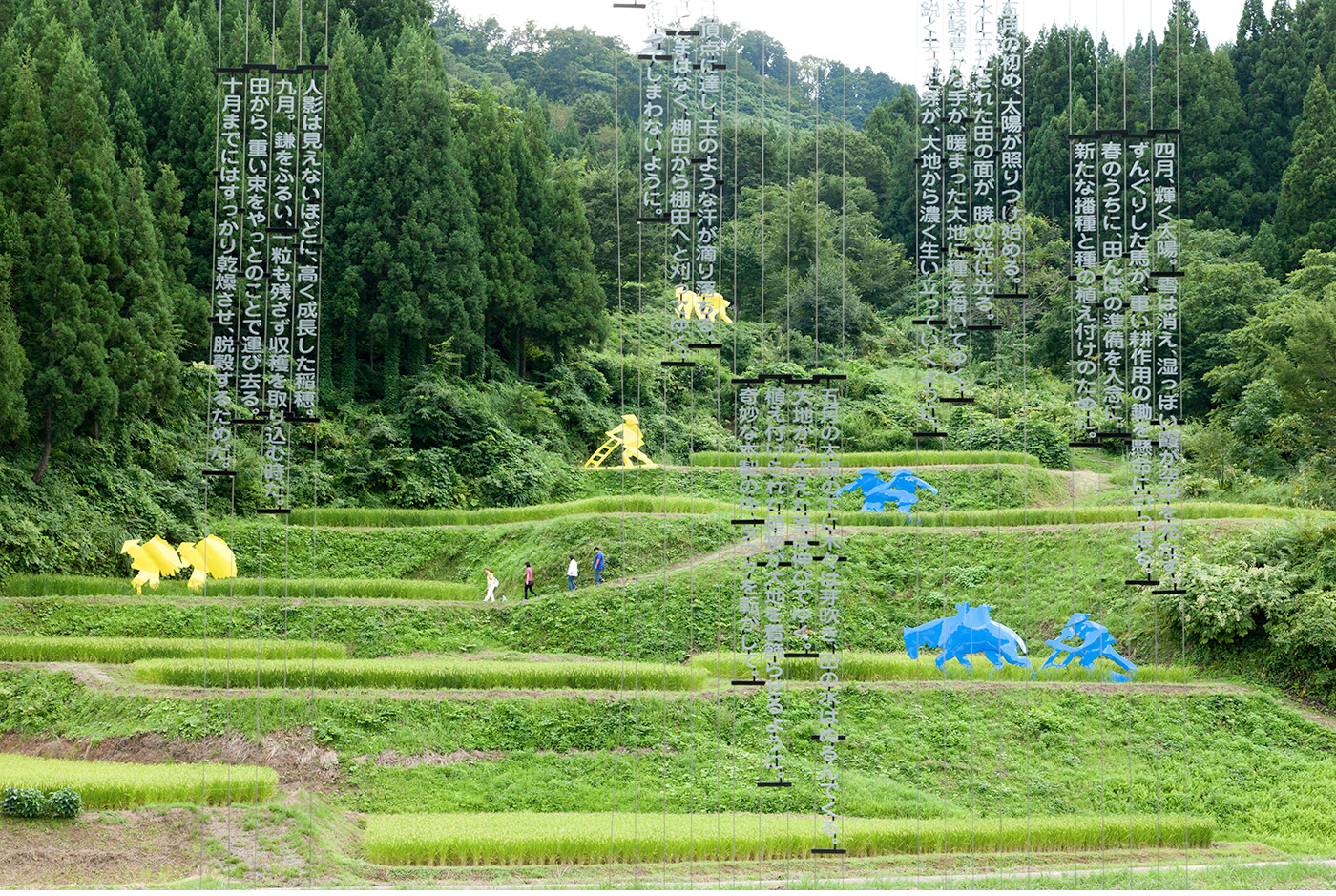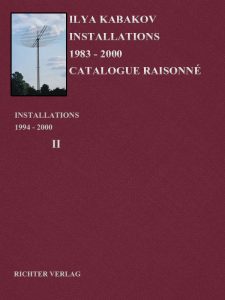The Rice Fields
with Emilia Kabakov
YEAR: 2000
CATALOG NUMBER: 153
PROVENANCE
Collection of the artist
EXHIBITIONS
Honcho, Tokamachi-city, Niigata, Japan
Echigo-Tsumari Art Triennial, 2000 20 Jul 2000 — 10 Sep 2000
Niigata Prefecture, Japan
Permanent installation in the Echigo-Tsumari-Region
DESCRIPTION
The project, in terms of concept, should consist of two parts: 1. a sculpture group on the other side of the river on the slope of the mountain; and 2. a frame with poetic texts on ‘this side.’ (‘This side’ of the river is the bank where the train station and future ‘Palace of Culture’ are located.) Moreover, the most interesting and most important part of the concept of the entire project is the connection of both of these parts into a single unified whole. It should be said that the meaning of both parts of the project are not equal. The sculpture group can exist entirely independently, it can be seen easily from all points of the terrain and from any distance. The frame with texts and the meaning of this frame can be understood and seen only by the person who is standing on the balcony of the ‘Palace of Culture’ and, moreover, he must be standing on the round step arranged in a specific spot on this balcony.
But we shall describe this entire project in order. First, about the five sculptures. They will be erected on the edges of the rice fields that rise up the mountainside in terraces, and they will be anchored below on special foundations. The height of the ‘nearest’ sculpture is 280 cm, the ‘farthest’ is 300 cm. They are made out of fiberglass that is semi-transparent. The sculptures are not round but rather are almost flat. The production cycle of rice served as the subject of the sculptures: 1. tilling the land; 2. planting the seed; 3. planting of seedlings; 4. weeding; 5. gathering the harvest. The figures, clothing of the peasants, and their working instruments – all of these are of a traditional nature.
The selection of the size of the figures and their coloring was important for the project. Such a size was selected so that the figures could be easily ‘read’ against the background of the green mountain (in summer) or the snow-covered mountain (in winter.) Moreover, they could be read not only from the side of the station, but also from the opposite mountainside, i.e. from a distance of 8-10 kilometers. The coloring, therefore, is soft but intense, consisting of two colors: three figures are yellow, two are light blue.
Now we shall move on to a description of the framed text. In the future ‘Palace of Culture’ it is proposed to build a balcony that looks out onto the river and mountain, a U-shaped form where the windows on the sides of the balcony are parallel to the river. A tall and wide metal frame painted silver is anchored in front of this side of the balcony. Five different texts consisting of 4 vertical lines each are stretched in thin wires inside this frame; the impression created is that these texts are hanging in the air inside the frame. (All the texts consist of metal hieroglyphs that are 4 x 4 cm each and painted silver, just like the ‘frame.’)
The entire trick of the whole concept of the installation is that when the visitors to the palace come out onto the open-air balcony and reach its middle, they see right in the center a round elevation. You can step up onto it, just like a step, but only one person at a time. Having stepped up onto it and looking through the frame in the direction of the mountain, the viewer suddenly sees that the texts optically coincide exactly with the sculptures standing far away from him on the mountain! Under each text, or above it, there is a sculpture that coincides with the corresponding text in meaning, and it is as though these figures become illustrations of these texts, and on the contrary, each text reveals the content of the activity depicted by the figures on the mountain. (These texts have an informative function, as well, since not everyone today knows how rice is produced.) Hence, it is as though what emerges before the reader/viewer standing on the step is a page of a book hanging in the air, wherein a single plane there is both a text and an illustration. Here are the texts of this ‘page.’
CONCEPT OF THE INSTALLATION
In 1999, we received an invitation within the framework of a large artistic project to make a permanent installation in the Echigo-Tsumari Region. Prior to this time, we had never been to this sparsely populated western mountain region of Japan, and we were astounded by the beauty of this place. It was the month of March, everything all around us was covered with snow, and we felt as though we had entered into the wintry landscapes of Utamaro and had become one of his figures. But from the organizers of the program as well as after our meeting with the town mayor, Mr. Tatsuji Sekiya, what was revealed to us was another, more prosaic, real side of this place: we learned and were shown in one of the museums just how difficult the life and work of the people living here are and how hard and what expenditures of labor the production of rice demands. We also learned of the hardships this region is experiencing at the present time – the new generation is not remaining in these places, it is leaving here, because the supremely difficult, many months of manual labor is ceasing to be ‘attractive.’
And the idea behind the proposed artistic program became clear to us – to attract attention to this region, to give it a new impetus, to give it an active resonance – this is precisely what contemporary art can bring to traditional regions.
For us, in particular, the theme that we should depict in our project became clear – the theme of hard labor in producing rice, the actual production in all of its phases from beginning to end – from the tilling of the land to the gathering of the harvest. This theme was also dictated by the location proposed for our project: a place on the other side of the river where the terraces of rice fields ascend up the mountainside. This entire panorama can be seen clearly from the side of the train station and the ‘Palace of Culture,’ which is to be built not far from the station. The ‘cultural zone’ around the future ‘Palace’ and the actual, difficult production on the other side of the river should be, in our opinion, connected in such a way that for the visitors of the Palace, for the residents of this region, the lofty significance of this production, of the traditional wealth of this place, becomes clear, and that is why it became the subject of artistic depiction. For the visiting tourists it should be clear that this production and the labor of these people deserves to have its own monument, a group of monuments visible from any place and from any, even the greatest, distance – and this monument is not to heroes, but rather to simple people who have labored in these fields for centuries.
Images
Literature






